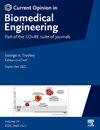Trans-epithelial/endothelial electrical resistance (TEER): Current state of integrated TEER measurements in organ-on-a-chip devices
IF 4.2
3区 工程技术
Q2 ENGINEERING, BIOMEDICAL
引用次数: 0
Abstract
Trans-epithelial/endothelial electrical resistance (TEER) is a non-invasive and quick method of assessing the integrity of barrier tissues. Traditional TEER measurement methods such as chopstick electrode-based and chamber-based measurements work well with static, Transwell-based models; however, the same methods do not directly apply to human-on-a-chip or organ-on-a-chip (OOC) platforms. With the wide variety of organ-on-a-chip devices, innovative designs to accurately measure TEER, without disturbing cells, are customized for various devices. Wire electrode integration, integrating a two-probe or four-probe technique, flexible printed circuit boards or multi-electrode glass substrate-based methods are some of the TEER measurement setups being utilized in conjunction with OOC systems. The variability in measurement setups associated with OOCs make standardization challenging; however, the field is working towards establishing guidelines on acceptable TEER values for different OOC constructs.

跨上皮/内皮电阻(TEER):器官芯片设备集成TEER测量的现状
跨上皮/内皮电阻(TEER)是一种非侵入性和快速评估屏障组织完整性的方法。传统的TEER测量方法,如基于筷子电极和基于腔室的测量方法,可以很好地与基于transwell的静态模型配合使用;然而,同样的方法并不直接适用于人体芯片或器官芯片(OOC)平台。随着各种各样的器官芯片设备,创新的设计,以准确地测量TEER,而不干扰细胞,为各种设备定制。线电极集成,集成双探头或四探头技术,柔性印刷电路板或基于多电极玻璃基板的方法是与OOC系统一起使用的一些TEER测量装置。与ooc相关的测量设置的可变性使标准化具有挑战性;然而,该领域正在努力为不同的OOC结构制定可接受的TEER值准则。
本文章由计算机程序翻译,如有差异,请以英文原文为准。
求助全文
约1分钟内获得全文
求助全文
来源期刊

Current Opinion in Biomedical Engineering
Medicine-Medicine (miscellaneous)
CiteScore
8.60
自引率
2.60%
发文量
59
 求助内容:
求助内容: 应助结果提醒方式:
应助结果提醒方式:


